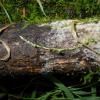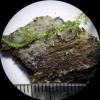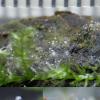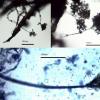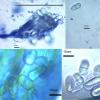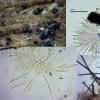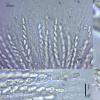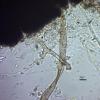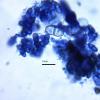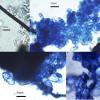
20-12-2025 23:08
Patrice TANCHAUDBonsoir, récolte sur sol sablonneux dans l'arri�

20-12-2025 15:47
Mirek GrycHi.These grew on pine wood that was heavily covere

18-12-2025 21:17
Pol DebaenstThe identification took me to Byssonectria deformi

15-12-2025 07:09
 Danny Newman
Danny Newman
indet. Rutstroemiaceae sp. on unk. fallen leavesMc

19-12-2025 10:10
Patrice TANCHAUDBonjour, récolte réalisée en milieu dunaire, a

18-12-2025 17:23
 Bruno Coué
Bruno Coué
Bonjour,je serais heureux d'avoir votre avis sur c

18-12-2025 18:07
Margot en Geert VullingsThese plumes were found on rotten wood.They strong

17-12-2025 18:35
 Michel Hairaud
Michel Hairaud
Bonjour à tous/Hi to everyone I am passing along
Cladobotryum with Chaetosphaeria?
Steve Clements,
06-08-2015 18:21
On a trouvé un Hyphomycete et un Pyrenomycete en habitant ensemble, sur Fagus.
Le Hyphomycete resemble Cladobotryum mycophilum, et le Pyrenomycete resemble Chaetosphaeria inaequalis. Qu'est-ce ce passe?
Cordialement,
Steve
Hi,
As I'm looking at corticioids I took a specimen of this large "crust". Found 29/7/15, Longshaw Estate, Peak District, Northern England, altitude about 300m. It was on the underside of a Fagus log (or at least, on a log by a large felled Fagus) in mixed woodland on acid Carboniferous gritstone.
The "crust" was composed of a Hyphomycete and a Chaetosphaeria type Pyrenomycete. I wondered whether the Hyphomycete was the anamorphic state of the Pyrenomycete. However, I don't think it is.
From Ellis & Ellis the Hyphomycete looks to be close to Cladobotryum – with one-septate hyaline conidia up to 21 x 10 um, on conidiophores (to 500 long by 8 wide, with "head" about 100 um) with phialides, it looks rather like C. mycophilum.
The Pyrenomycete is up tp 0.2mm diameter, single small ostiole, associated with setae (septate, up to 200 long, about 5 wide with slightly swollen ends). The asci do not turn blue in Lugol, and are approx 100 x 5-6. They have an apical ring. Spores are single septate, up to 9x4.5, assymetrical, and appear to splt into two part-spores about 3x4.5 um. After several days some part-spores germinated. Paraphyses are thread-like and difficult to see. If this is a Chaetosphaeria then from Ellis & Ellis and Reblova (SIM 45, 149-168) the closest I get is to C. inaequalis.
As no species of Chaetosphaeria has an anamorph similar to the Hyphomycete present, I wonder if it is parasitsing the Pyrenomycete – although I appreciate that it has only been recorded on larger Basidiomycetes.
Microscopy in Methylene Blue.
Best regards,
Steve
Andrew N. Miller,
06-08-2015 18:28

Re : Cladobotryum with Chaetosphaeria?
Those are not Chaetosphaeria ascospores. Look more like some Dothideomycetes ascospores to me.
Andy
Andy
Steve Clements,
06-08-2015 22:58
Re : Cladobotryum with Chaetosphaeria?
Hi Andy,
Thanks.
Haved just looked on Wikipedia:
Dothideomycetes:
11 orders 90 families, 1300 genera and over 19,000 known species.
Cheers,
Steve
Thanks.
Haved just looked on Wikipedia:
Dothideomycetes:
11 orders 90 families, 1300 genera and over 19,000 known species.
Cheers,
Steve
Andrew N. Miller,
07-08-2015 15:57

Re : Cladobotryum with Chaetosphaeria?
Exactly! Good luck! LOL! There are many species of Dothideos that have ascospores like these. Someone needs to make a good key to this Class of Fungi.
Andy
Andy
Steve Clements,
08-08-2015 12:37
Re : Cladobotryum with Chaetosphaeria?
Thanks Andy,
I must admit I am now thoroughly scared off these tiny but very common little black single ostiole flasks with accompanying forests of setae. Would you expect a fairly reasonably informed field mycologist to be able to tackle them? It looks like our "comprehensive" fungi survey of the Longshaw Estate is going to be anything but - in terms of being able to name all our finds even to the correct big group eg Class.....
However, I'lll continue to record anything we find, put the data into computer folders, and keep specimens when possible.
Is there any way of distingishing bitunicate asci apart from getting hold of an expensive microscope – eg specific stains?
Cheers.
Steve
I must admit I am now thoroughly scared off these tiny but very common little black single ostiole flasks with accompanying forests of setae. Would you expect a fairly reasonably informed field mycologist to be able to tackle them? It looks like our "comprehensive" fungi survey of the Longshaw Estate is going to be anything but - in terms of being able to name all our finds even to the correct big group eg Class.....
However, I'lll continue to record anything we find, put the data into computer folders, and keep specimens when possible.
Is there any way of distingishing bitunicate asci apart from getting hold of an expensive microscope – eg specific stains?
Cheers.
Steve
Andrew N. Miller,
08-08-2015 15:58

Re : Cladobotryum with Chaetosphaeria?
I am by no means an expert on the pyrenos or loculos despite looking at thousands of specimens over the years. One usually picks a group and tries to understand them. There are over 30,000 species of pyrenos and loculos! Many of the pathogenic and aquatic loculos have been sequenced, but we know almost nothing about the terrestrial wood-inhabiting loculos.
I often do not see 2 wall layers in the asci of loculos, but one can observe an apical thickening in the asci of many species, which is a clue that it is a loculo. After awhile, one becomes familiar with the ascospores, which also helps put the species into one of the two groups. For example, dictyospores are very rare in pyrenos.
Best,
Andy
I often do not see 2 wall layers in the asci of loculos, but one can observe an apical thickening in the asci of many species, which is a clue that it is a loculo. After awhile, one becomes familiar with the ascospores, which also helps put the species into one of the two groups. For example, dictyospores are very rare in pyrenos.
Best,
Andy
Steve Clements,
08-08-2015 23:05
Re : Cladobotryum with Chaetosphaeria?
Thanks again Andy,
It's useful to put things into perspective and recognise the limits to one's abilty ... and time, to tackle these fungi. It is also nice to know that we have plenty more fungi to discover and describe, like maybe 95%!
Cheers,
Steve
It's useful to put things into perspective and recognise the limits to one's abilty ... and time, to tackle these fungi. It is also nice to know that we have plenty more fungi to discover and describe, like maybe 95%!
Cheers,
Steve

